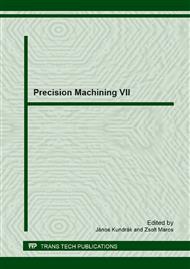[1]
Benedetti, M., Fontanari, V. Influence of Residual Stress Relaxation on Plain and Notch Fatigue of Shot Peened Al-7075-T651. SEM Proceedings, 2009, New Mexico, USA.
DOI: 10.1016/j.proeng.2011.04.363
Google Scholar
[2]
L. Bumbálek: Importance of Surface Structure for the Function of Machined Surface. Manufacturing Technology, vol. 1 (2001), p.10 – 15.
Google Scholar
[3]
F. Hashimoto, Y. B. Guo, A. W. Warren: Surface Integrity Difference between Hard Turned and Ground Surfaces and Its Impact on Fatigue Life. Annals of the CIRP, vol. 55/1/(2006).
DOI: 10.1016/s0007-8506(07)60371-0
Google Scholar
[4]
F. Holešovský: Formation and meaning of residual stress of ground surfaces. International Journal of Computational Materials Science and Surface Engineering, No. 1, vol. 3 (2010) pp.52-63, ISSN 1753-3465.
DOI: 10.1504/ijcmsse.2010.029682
Google Scholar
[5]
F. Holešovský, M. Hrala, J. Zelenková: Ground Surface – Formation and Changes at Dynamical Loading. Manufacturing Engineering, 2/2006, pp.13-17, ISSN 1335-7972.
Google Scholar
[6]
F. Holešovský, M. Hrala, J. Zelenková: Properties of Ground Surfaces and Significance of Grinding Process. Proceedings 4th International Congress ICPM (2007), Kielce, Poland, pp.23-27, ISBN 978-83-88906-91-6.
Google Scholar
[7]
F. Holešovský, M. Hrala, J. Zelenková: Changes of Ground Surface Properties at Dynamical Loading. Technological Engineering, 2/2007, ISSN 1336-5967.
Google Scholar
[8]
S. Malkin: Grinding Technology – Theory and applications of machining with abrasives, SME, Deaborn, Michigan (1989).
Google Scholar
[9]
D. I. Marinescu, M. Hitchiner, etc.: Handbook of Machining with Grinding Wheels. CRC Press, Taylor&Francis Group, New York.
Google Scholar
[10]
M. N. Morgan and I. D. Jenkinson: Advances in Manufacturing Technology – XX. Proceeding of John Mores University, Liverpool (2006).
Google Scholar
[11]
M. Růžička: Search for Multiaxial Fatigue Solution. In: Fatigue 2006 - Delegate Manual. Oxford: Elsevier (2006) pp.152-153.
Google Scholar
[12]
K. Wieczorowski and S. Legutko: Investigation of Influence of Grinding Parameters on Shape Errors and Surface Roughness of Holes. Manufacturing Technology, vol. 8 (2008) p.21–25.
Google Scholar
[13]
Y. Xu, T. Zhang, Y. Bai Effect of Grinding Process Parameters on Surface Layer Residual Stress. Advanced Materials Research, vol. 135 (2010) , Trans Tech, Switzerland.
DOI: 10.4028/www.scientific.net/amr.135.154
Google Scholar


